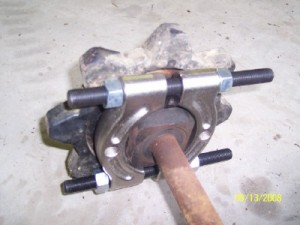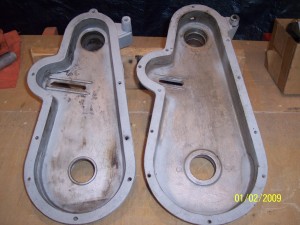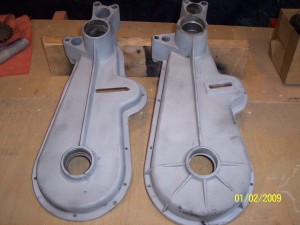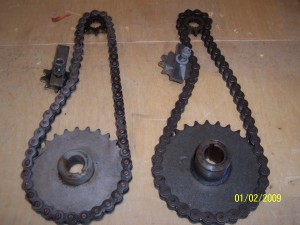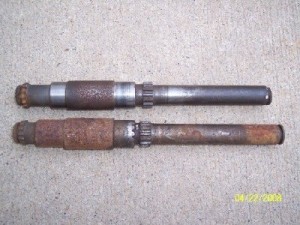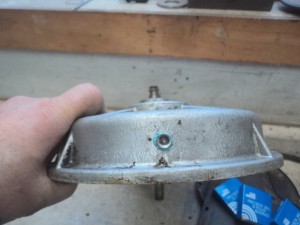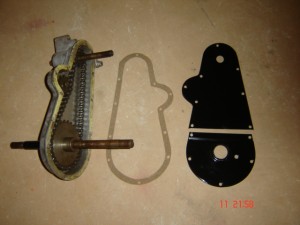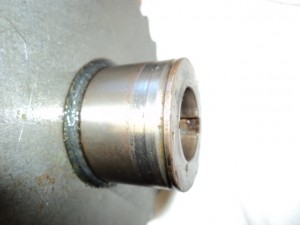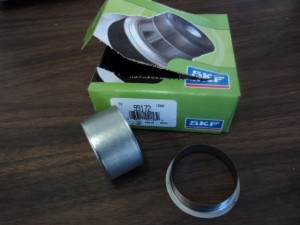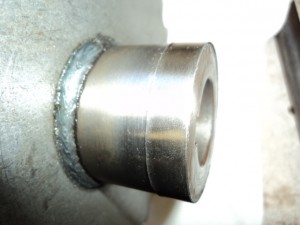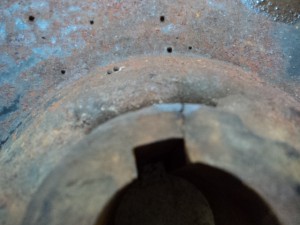Above is the gearbox used on all 502 and 503 models. The unit is a simple chain and sprocket gearbox with 3 bearings and an oil seal. The 500 gearbox is very similar but much more delicate than the 502/3 gearbox.
Getting the gearbox apart without breaking it is tricky without the right tools. The only good way I have found to get the sprockets off is to use a bearing separator (upside down) in a press. Do not press on the bearing retainer as it will bust easily. It also squashes the aluminum spacer between the bearing retainer and sprocket. The bearing separator needs to be installed in a way that the pressure from the press is forcing down on the inner sprocket hub and not out around the rubber. Pressing the sprockets off by supporting near the rubber will surely wreck the sprockets and they won’t be good for cores.
This bearing separator is available at McMaster and is P/N 6342K2
Once the sprockets and bearing retainers are removed. The gearbox can be taken apart. Above are comparisons of the original designed gearbox out of the 500 (parts on the left in each photo) and the 502/503 gearbox (parts on the right in each photo. A couple key differences include:
- The 500 gearbox housing is much more delicate than the 502/3 gearbox. Improvements on the later housing includes more cover bolts (increased from 8 to 11), a cover that has edges folded in toward the gearbox housing, thicker aluminum around the lower bearing (from 1/8″ to 1/4″), a wider seal hub on the driven sprocket (from 11/16″ to 1-1/4″), reinforcements around the idler sprocket along with a central location design, gussets on the outer housing and an additional lube fill hole on the top.
Note: you may come across a gearbox from a 500 that has 9 or 10 cover bolts. I suspect there were gearboxes made late in the 1967 production year as Bolens observed problems with leaks and tried to resolve the issue by adding more cover bolts.
- The center to center distance between the input and output shaft are different. The 502/3 gearbox has about 1/4″ more distance between the two shafts.
– The gear ratio is different. The 500 has a 9 tooth drive sprocket and 26 tooth driven sprocket giving it a gear ratio of 2.88:1. The 502/3 has a 10 tooth drive sprocket and 28 tooth driven sprocket giving it a gear ratio of 2.8:1. All things being equal with engine RPM, clutch condition and belt wear, the 500 should have had slightly more power but less speed than the 502/503.
The input shafts are different between the 500 & 502/3. The left picture shows the 500 shaft above (9 5/16″ long) and the 502/3 shaft below (9 3/4″). The gear splines look similar, but I don’t think they are the same. The weak link is the spline for the connection between the brake disc and shaft. It often wears out.
#50 Rex chain is used in both gearcases. All the bearings in the gearbox along with the two track adjustment bearings are 6205-2RS (five total – this is a standard bearing number supplied by most bearing manufactures and measures 52mm x 25mm x 15mm wide). A National 204503 (one required) is used in the gearcase cover. However, another seal that is the same inside and outside diameter but thicker is a Timken 473237. The thicker double lipped seal puts more rubber on the sprocket shaft creating a better seal (Thanks for sharing this Barrie).
The remaining dis-assembly is fairly straight forward. The input shaft can be pressed out either direction after removing the snap ring. Support the housings and press out the bearings. The sprockets usually come off with little effort. Although the 500 and the 502/3 gearboxes are different, they come apart the same way. Note where the spacers are.
- The 500 gearbox has a 5/8″ spacer behind the Driven Sprocket and a 1/2″ spacer behind the Drive Sprocket.
- The 502/3 gearbox has 7/16″ spacers behind both Sprockets.
- Both gearboxes have a 7/8″ spacer between the Drive Sprocket and the Secondary Clutch.
- Both drives have spacers with a ring cut in them between the bearing retainer and the Rubber Drive Wheels.
While the gearbox is apart, install a drain plug in the bottom. I use flush 1/8″ NPT plugs. This allows you to drain the water and oil out of the gearbox in the spring and add fresh 90w oil come fall.






